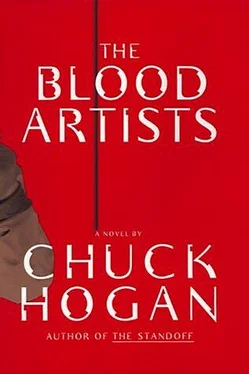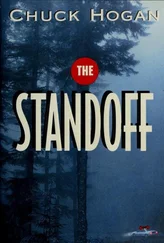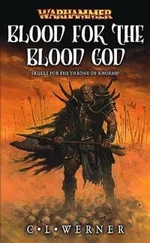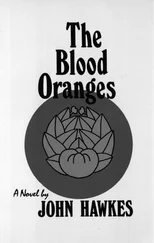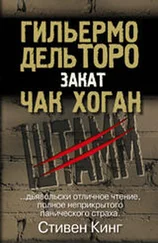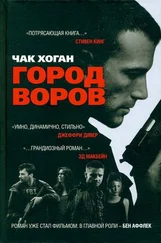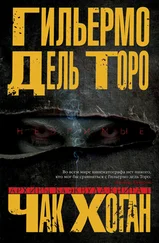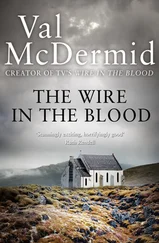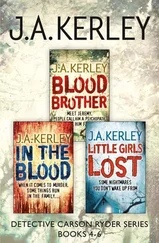“A massive cleanup,” I said, thinking ahead.
Peter looked around at the cave and the road and the morning trees. A wild plant was growing in the shadow of the cafeteria, its leaves spindly and fevered with overripe color. He uprooted it with his booted heel, and kicked it into the killing light. He said, “Leave that to me.”
In the afternoon of the third day I was called away from the marketplace trauma by a young girl in her mid-teens on the healthy side of the quarantine line. She was attractive, even remarkably so, with expressive eyes and a chestnut face almost more sculpted than functional, but inside the charnel house this was just another detail among details, an identifying trait I might have listed along with size and weight on her chart, and in truth a feature not nearly as remarkable as the spectacular disfiguring qualities of the disease. What did distinguish the girl were the stains of vitiligo over her neck and arms, and what I could see of her shins below the hem of her banana-yellow skirt, dappled with depigmented, strikingly pale pink flesh that, in my haze, I first mistook for symptoms of the scourge, and which brought me to her. The young woman’s eyes, however, were white and clear.
She began begging me, in quiet, controlled French, to take her away. Save me from this death, she said, her fingers plying at the red-orange fabric of my chest. Her entreaties became more desperate as I continued to decline, but she pleaded and pleaded, even offering herself to me, anything, grabbing on to my suit, until finally I had to wrest her hands and thrust her away. She dropped to her knees in the grass on the healthy side of quarantine, and continued calling after me.
Later that day, one of the nurses brought me Dr. Kaunda. His eyes were bloodshot and glazed, and small lesions had appeared over his body, and he complained of prostrating lower back and abdominal pain. He was still muttering something about quinine. The muscles of his face were lax and formless. The depersonalization phase had begun. I dosed him with Seconal to allow him some sleep, and moved on.
That evening, as I walked in on Peter in the dispensary, working over a corpse, I saw that his head was exposed. He had severed his rubber contact suit at the neck and removed the hood in favor of a respirator and a simple cotton surgical cap. The suit was taped sealed to his thick neck, while the decapitated hood piece lay on its side on the floor across the room.
He saw me in the doorway, looking up from his corpse. There was no explanation, no regret. No apology nor even defiance.
Though I strove to return a similarly cool expression, I certainly failed, and finally left without saying a word, proceeding to the hut behind the dispensary.
Jacqueline Moutouari’s face was no longer distinguishable. I had seen decomposed bodies before and that was what she looked like now. She was breathing in short, feral breaths with extended pauses in between. Each one seemed her last.
Peter appeared next to me. He was rubbing something sticky off his gloves and looking at her. She clutched at her chest with tiny, crooked fingers.
“End it,” Peter said.
The Seconal kit was in my gloved hands. I felt its weight and wondered, as though it were the greatest question in the universe, whether or not I had intended to bring it there. Seconal was a powerful barbiturate sedative, and when administered in significant dosages, was considered a humane instrument of physician-assisted death.
Peter grew impatient. “Give me the kit,” he said. He did it himself. Her pulse rate began to fade and, in less than thirty minutes, stopped.
I buried her myself. It was backbreaking work. I buried her behind the dispensary, away from the others.
Peter later abandoned the autopsy room and joined me out in the makeshift hospital, having capped and chilled many more biological samples than we would ever need. His protective gear had changed again, and now consisted merely of a lighter half mask that provided not much more protection than a simple surgical shield, goggles, and half-arm gloves taped to bloody cotton surgical scrubs. He had covered only the vulnerable membranes of his eyes, nose, ears, and mouth. The contact suit was gone. A nurse next to me saw him and gasped but I kept right on working. Peter was able to move more easily than the rest of us, and flaunted this advantage, rotating from patient to patient with breezy dispatch, like a barber inspecting haircuts. Later that evening I asked him for 2 cc of his blood. It came back negative for viral infection. Peter was clean.
When I was first getting to know my third-year roommate at Yale, I ignored Peter’s boasting of never having been sick. I was myself descended from a long line of New York Episcopalians who claimed the same, my grandfather having “never missed a day of work in his life,” simply by going to meetings ill and routinely infecting half of Wall Street. This was the starched white underpinning of my Protestant Yankee work ethic.
But as I came to know Peter, I watched as he immersed himself in the petri dish of university life without forfeiting a single class to illness; without contracting the case of mononucleosis that kept me, his finals study partner, from participating in the graduation ceremonies; without ever catching so much as a sniffle. I witnessed more of the same as we continued together through medical school: a defiance toward illness that went beyond the bragging of an extraordinarily hardy constitution. In our second year at Emory, in the CDC virology track, each candidate had to submit to a battery of inoculations before being allowed access to the most dangerous biological agents. Peter was the only one to smile through the endless vaccinations — yellow fever, Q fever, Rift Valley, tularemia, anthrax, hepatitis A and B, typhoid, meningitis A type and C type, and multiple flu and encephalitis strains — tolerating each of these and more without any side effects, without developing even the slightest rash or headache.
The clincher came a few months later, when Peter was contact-traced by the CDc’s own Crimes of Infection branch as having been seated on a recent flight from Seattle to Atlanta two rows in front of a man infected with multidrug-resistant tuberculosis. Untreatable MDR-TB was the second most prevalent infectious disease in the world, and in the United States it was illegal for carriers to fly on commercial airlines. Contact tracing had turned up all 221 passengers and members of the flight crew, and all were found to have contracted the incurable disease during the five-hour flight, and all went on to secure enormous financial compensation from the airline. All except Peter Maryk. He was the only passenger who did not collect. He had been exposed with the others, and yet somehow had thrown off the incurable disease. A battery of tests proved this. The only sensation of discomfort he recalled was one of exhaustion shortly after landing, which he slept off lying across three chairs inside the airport terminal.
I set to work, initiating a series of laboratory tests exposing samples of Peter’s blood to infectious agents both viral and bacterial. He demonstrated resistance to each, and in time and in secret, Peter began exposing himself to some of the more exotic, non-lethal viruses. He cast each one aside without manifesting a single symptom, and with only one unusual side effect.
The more serious exposures were followed by a period of mononucleoticlike languor, the duration of which varied according to the pathogenicity of the infectious agent, ranging from brief periods of sluggishness to deep re-energizing sleep. The effort required to expel invaders from his system prompted an overall energy drain, which Peter termed a “cascade.” This typically meant his slumping in a corner chair following an exposure, as though dawn had found him the last survivor of a wild party with no ride home. When it compelled him to sleep, which was rare, he slept soundly, nearly unconscious. Given his imposing physical appearance and his superhuman immunological strength, these cascades were the only times he ever appeared vulnerable.
Читать дальше
